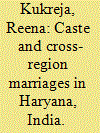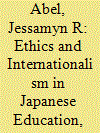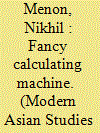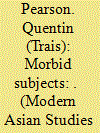|
|
|
Sort Order |
|
|
|
Items / Page
|
|
|
|
|
|
|
| Srl | Item |
| 1 |
ID:
160156


|
|
|
|
|
| Summary/Abstract |
Anthropological studies of India's post-liberalization middle classes have tended to focus mainly on the role of consumption behaviour in the constitution of this class group. Building on these studies, and taking class as an object of ethnographic enquiry, I argue that, over the last 20 years, class dynamics in the country have been significantly altered by the unprecedentedly important and complex role that the English language has come to play in the production and reproduction of class. Based on 15 months of ethnographic fieldwork—conducted at commercial spoken-English training centres, schools, and corporate organizations in Bangalore—I analyse the processes by which this change in class dynamics has occurred, and how it is experienced on the ground. I demonstrate how, apart from being a valuable type of class cultural capital in its own right, proficiency in English has come to play a key role in the acquisition and performance of other important forms of capital associated with middle-class identity. As a result, being able to demonstrate proficiency in English has come to be experienced as a critical element in claiming and maintaining a space in the middle class, regardless of the other types of class cultural capital a person possesses.
|
|
|
|
|
|
|
|
|
|
|
|
|
|
|
|
| 2 |
ID:
160154


|
|
|
|
|
| Summary/Abstract |
This article, based on original research in 75 villages in the North Indian state of Haryana, examines long-distance marriages of its dominant-peasant caste men with low-caste (Dalit) women from other parts of India. The male marriage squeeze caused by the female deficit in Haryana has led to this breach in the rules of caste endogamy in matrimony. These marriages and the gender status of such Dalit brides are situated within the context of polarized caste relations, caste contestations, and caste violence against local Dalits in Haryana. Long-distance alliances, through fabricated, high-caste identities of the brides, tactically circumvent prohibitions on local inter-caste marriages and provide legitimacy to continued, local, unequal hierarchies of caste relations. Intersecting oppressions of caste, gender, and patriarchy exacerbate gender subordination within both the home and community for Dalit cross-region brides. Caste-exclusionary behaviours and discriminations are strategically employed to assert caste supremacy and subdue women's resistance. The caste stigmatization of these brides carries over to their children who face inter-generational discrimination in daily interactions and marriage prospects because of their ‘diluted’ Jat identity and low-caste status. The article provides examples of Dalit brides’ agency through resistance strategies.
|
|
|
|
|
|
|
|
|
|
|
|
|
|
|
|
| 3 |
ID:
160153


|
|
|
| 4 |
ID:
160158


|
|
|
|
|
| Summary/Abstract |
This article argues that ideas of health and disease in the Assam tea plantations of northeastern India exceeded instrumental logics of bodily disorder, medical ‘objectivity’, and preventive cure. It looks at cholera, kala-azar (or black-fever), and malaria—the three main killers in these estates—to show that imperatives of private capital and law conditioned and constrained parameters of well-being, mortality, and morbidity in these plantations. It therefore suggests that epidemiological theories and praxis emerged from a simultaneous—but expedient—reading of three versions of the labour body: the pathological, the productive, and the legal. The overlaps between commerce, law, and pathogens provide for a unique, if not exceptional, social history of health in colonial India.
|
|
|
|
|
|
|
|
|
|
|
|
|
|
|
|
| 5 |
ID:
160155


|
|
|
|
|
| Summary/Abstract |
After their government's 1933 withdrawal from the League of Nations, Japanese internationalists searched for new ways to engage with the world or struggled to accommodate their advocacy of international cooperation to the realities of the wartime empire. The idea of international morality was central to this effort. Ethics textbooks, which presented ideals of international behaviour, provide a particular view of this intellectual and policy endeavour of the 1930s and early 1940s, showing how the concept of morality became a means to reconcile internationalism with imperialism and war. Echoing many of the ideas current in both public discussion and behind-closed-doors decision-making on foreign policy at the time, textbook authors and other educators contributed to a broader redefinition of internationalism that enabled it to persist through a period of imperialism and war.
|
|
|
|
|
|
|
|
|
|
|
|
|
|
|
|
| 6 |
ID:
160152


|
|
|
|
|
| Summary/Abstract |
In the middle of the twentieth century, statistician P. C. Mahalanobis strove to haul India into the computer age. Convinced that these machines were integral to the future of economic planning in India, he and the Indian Statistical Institute mounted a campaign to bring India its first computers. In the years following independence, Mahalanobis and the Indian Statistical Institute acquired significant influence in the Indian planning process—culminating in them effectively authoring India's Second Five-Year Plan (1956–61). The tale of the computer's journey to India demonstrates that the decision to centrally plan independent India's economy, and the resultant explosion of official statistics, provided the justification for the pursuit of computers. They potentially solved what was considered centralized planning's greatest puzzle: big data. Mahalanobis persuaded the Indian government of the need to import computers for the purposes of development, and then negotiated the import of these exorbitantly expensive machines during visits to Europe, the United States of America and the Soviet Union. Needless to say, the question of which country would provide India its first computers would ruffle Cold War feathers. This article brings together and identifies a link between the research activities of the Indian Statistical Institute, its deepening association with economic planning and the installation of India's earliest computers.
|
|
|
|
|
|
|
|
|
|
|
|
|
|
|
|
| 7 |
ID:
160160


|
|
|
|
|
| Summary/Abstract |
Mount Paektu/Changbai is a massive stratovolcano situated on the current border between North Korea and China, in a region that has historically lain at the edges of competing Eurasian polities. Formed by a past of dramatic eruptions, Mount Paektu/Changbai has long been held as a powerful, sentient entity by those living near it, but the mountain's unique geographical features and distance from political centres rendered it extremely elusive as an object of elite empirical knowledge. This article examines narratives of multiple expeditions to Mount Paektu/Changbai from the seventeenth to the twentieth centuries in order to understand the role of space in the creation of knowledge about the mountain, and to probe how that knowledge intersected with political goals. Consideration of human experience of the mountain's topography and environment reveals a complex relationship between proximal and distal perceptions of nature. Even as they sought to create rational, ‘universal’ forms of knowledge about the mountain, Asian elites appropriated more localized belief in the mountain's powers, creating a hybrid knowledge that combined science and miracles. As the political context shifted in the late nineteenth century, the positioning of this hybrid knowledge shifted to become an indiginized basis for national resistance. This consideration of Mount Paektu/Changbai highlights the virtues of making space and environment central to the political and cultural history of northeast Asia.
|
|
|
|
|
|
|
|
|
|
|
|
|
|
|
|
| 8 |
ID:
160157


|
|
|
|
|
| Summary/Abstract |
Siam managed to replace royal absolutism with limited monarchy in June 1932 without any chaos or bloodshed. But the transition quickly proved to be far from complete. The country was to undergo a major upheaval before suffering a semi-civil war only about a year after the princely rule was toppled. The new regime, accordingly, began to consider its constitution as a symbol behind which the people could be mobilized. A massive campaign for the document was then launched in late 1933 and it soon culminated in what can be regarded as the practice of constitution worship. This article will look at the campaign in detail, especially with respect to its underlying logics; the aim is to reveal and analyse the attempt by the revolutionary regime to transform the first permanent constitution into a sacred entity. Meanwhile, in pursuing such an aim, this article will shed light on the formation of a constitutional culture in Siam. Given that a basic law had never existed in the country, the article will discuss not only how the state promoted the permanent constitution, but also how the Siamese society encountered and experienced constitutional rule for the first time.
|
|
|
|
|
|
|
|
|
|
|
|
|
|
|
|
| 9 |
ID:
160151


|
|
|
|
|
| Summary/Abstract |
This article examines the question of Siamese sovereignty in the era of high imperialism through the lens of medical jurisprudence. Although Siam (Thailand) was never formally colonized, it was subject to unequal trade treaties that established extraterritorial legal rights for foreign residents. In cases where a foreign resident was suspected of having harmed a Siamese subject, the Siamese state had to appeal to foreign consular officials to file charges against the suspect. Standards of forensic evidence were crucial in such cases. While medical jurisprudence helped to bolster racial privilege in other colonial legal jurisdictions, this article argues that these disputes rendered the dead and injured bodies of Siamese subjects into potentially powerful pieces of leverage against foreign residents and their political representatives. The dead bodies of Siamese subjects became grounds for challenging foreign courts and asserting Siamese sovereignty.
|
|
|
|
|
|
|
|
|
|
|
|
|
|
|
|
| 10 |
ID:
160159


|
|
|
|
|
| Summary/Abstract |
The Bengali bhadralok have had an important impact on Indian nationalism in Bengal and in India more broadly. Their commitment to narratives of national progress has been noted. However, little attention has been given to how ‘earthly paradise’, ‘garden of delights’, and related ideas of refinement and nobility also informed their nationalism. This article excavates the idea of earthly paradise as it is portrayed in Satyajit Ray's 1958 Bengali film Jalsaghar, usually translated as The Music Room. Jalsaghar is typically taken to depict, broadly, the decadence and decline of aristocratic ‘feudal’ landowners (zamindars) who were granted their holdings and, often, noble rank, such as ‘Lord’ or ‘Raja’, during Mughal or British times, representing the languid past of the nobility, and the ascendance of a restless business-oriented class that represents an emerging present and possible future. The zamindars are shown as pursuing aesthetic and spiritual delight, ecstasy, and edification through soirées. These soirées are produced for those among the nobility who are sufficiently cultivated and cosmopolitan to appreciate the finer things in life, such as the classical music and dance showcased in this film. The businessmen, too, aspire to host such exceptional events, but are too crass to do so properly and, moreover, they are motivated by a desire to accrue prestige, thus using soirées as a means to an end, rather than to experience aesthetic and spiritual elevation as an end in itself. I argue that the film calls on the bhadralok to value aesthetic cultivation and to actively counter its evanescence. The film thus beckons and authorizes the bhadralok to sustain the value of the timeless past, including nobility and refinement. Yet the bhadralok are also expected to embody and expand a new, progressive, and utilitarian spirit that would modernize India. With the aristocrats gone, and the entrepreneurs eager to assume authority, the film charges the bhadralok to construct a nationalism in which the immortal, character-building values of classical art, for example, can yet be sutured to utilitarian progressivism. I argue that the film conveys this even though it does not explicitly portray or even mention the bhadralok, or feature uniquely Bengali music and art. Accordingly, this article does not focus on the actual aesthetic and political practices of bhadralok nationalism. The aim is to shed light on one genealogy through which the bhadralok sanctioned themselves as India's stewards along these lines.
|
|
|
|
|
|
|
|
|
|
|
|
|
|
|
|
| 11 |
ID:
160150


|
|
|
|
|
| Summary/Abstract |
Rajnarayan Chandavarkar—Fellow of Trinity College and Reader in History at the University of Cambridge—passed away on 23 April 2006. In addition to a rich legacy of books and articles that were published in his lifetime, he left behind an enormous amount of manuscript material, much of which was ready for publication. A selection of this material was published in his posthumous History, Culture and the Indian City (Cambridge University Press, 2009), but new manuscripts continue to come to light. His wife, Jennifer Davis, recently found this essay among his effects. There is good reason to believe that Raj felt it was ready for publication. Therefore, we publish this essay almost exactly as it appears in his typescript, only correcting typos and minor errors, and adding a map. The editors would like to thank David Washbrook and Jennifer Davis for proofing this article, Uttara Shahani and Binney Hare for researching and adapting the map, and Francoise Davis for the photograph of Raj.
|
|
|
|
|
|
|
|
|
|
|
|
|
|
|
|
|
|
|
|
|